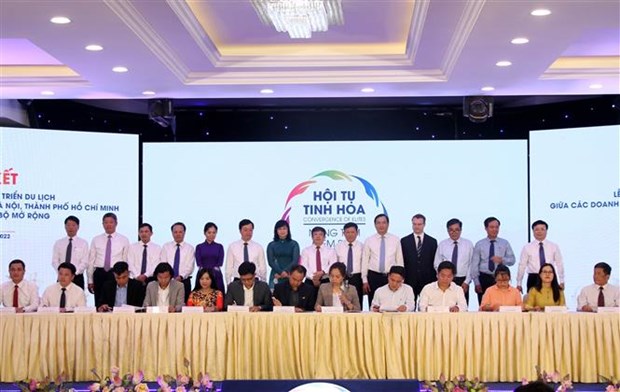 Society
Society


|
| Representatives of 29 tourism businesses from Hà Nội, HCM City and the north-central region signed agreements to link tourism development on July 1 in Nghệ An Province. — VNA/VNS Photo Văn Tý |
HCM CITY — Tourism links would boost activity in each locality, contribute to the promotion of local tourism brands in the domestic market and enhance the competitiveness of Vietnamese tourism in the international market, vice chairwoman of the HCM City People's Committee Phan Thị Thắng said at a recent forum on linking tourism development.
The forum was held in Nghệ An Province last Friday to foster tourism links between Hà Nội, HCM City and six north-central provinces of Nghệ An, Ninh Bình, Thanh Hóa, Hà Tĩnh, Quảng Bình and Quảng Trị.
Phan Thị Thắng said besides tourism links within the north-central region, the six provinces needed to boost tourism cooperation with key tourism regions, and create unique tourism products.
“With experience in developing tourism linkages with other regions, HCM City suggested that each locality needs to have a specific plan as soon as possible in order to be truly effective in creating tourism linkages,” she said.
It was also necessary to soon implement tourism promotion programmes to increase the number of tourists and travel revenue in the summer tourism peak, she said.
According to Nguyễn Đức Trung, chairman of Nghệ An Province’s People’s Committee, the province plays the role of a tourism connection centre in the region, with its favourable geographical location, and diverse tourism potential.
Cooperation and linkages in developing tourism services and products will help to create new tourism products and attractive tourism programmes that could meet the interests of domestic and foreign tourists.
Creating tourism linkages between the north-central region and the two most popular travel destinations of Hà Nội and HCM City is expected to help exchange customer resources, develop strategies to attract more investment in tourism development, make changes to the face of tourism in each locality, and improve the quality of tourism facilities of the whole region.
Trương Đức Hùng, deputy general director of Saigon Tourism Corporation (Saigontourist Group), said it was necessary to promote linkages between provinces in the region to form inter-regional destinations and create unique products such as cultural tourism, eco-tourism, or sea tourism.
“Linking with travel companies and transport businesses, including aviation, railway and buses, is also needed to create attractive travel products,” he said.
To ensure the quality of tourism services, it was necessary to strengthen the management capacity of local authorities, provide vocational training and teach foreign languages to workers in the tourism sector and train locals to join tourism activities linked between localities in the region, he said.
Upgrading transport infrastructure systems connected to tourism destinations, and improving the quality of accommodation, entertainment and sports facilities were also needed, he said.
The forum attracted the participation of more than 500 delegates from ministries, departments, branches, associations, corporations, domestic and international tourism enterprises, experts, and domestic and foreign press agencies.
At the forum, 29 tourism businesses from Hà Nội, HCM City and the north-central region signed agreements to link tourism development.
This is the sixth linking tourism development programme of HCM City after establishing tourism connections with 13 provinces and cities in the Cửu Long (Mekong Delta), the southeast region, the northwest region, the northeast region, and major economic centres in the Central region.
Tourism linkage is very important for the recovery of Việt Nam’s tourism after nearly two years of negative impacts of the COVID-19 pandemic.
The removal of restrictions on international flights has created a golden opportunity for the country's tourism industry, especially domestic tourism.
The tourism sector targets to serve 65 million visitors this year, including five million foreigners, and earn VNĐ400 trillion (US$17 billion). — VNS




